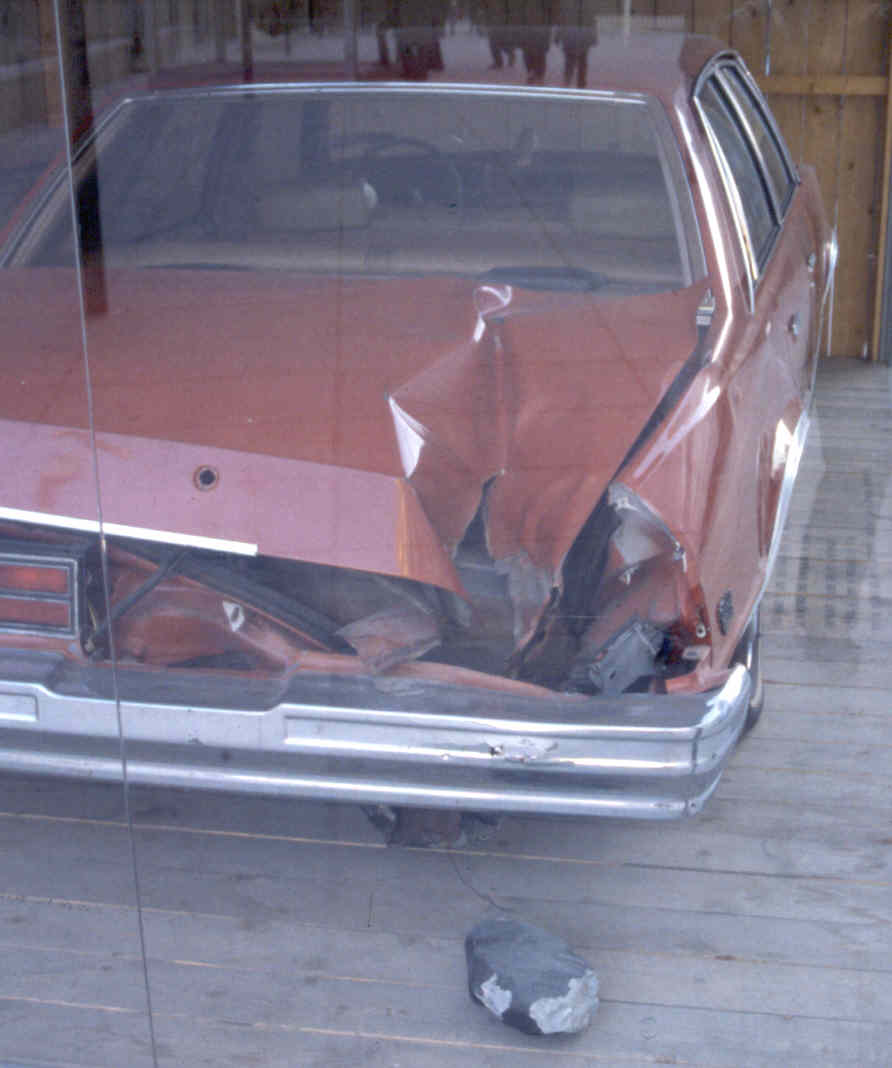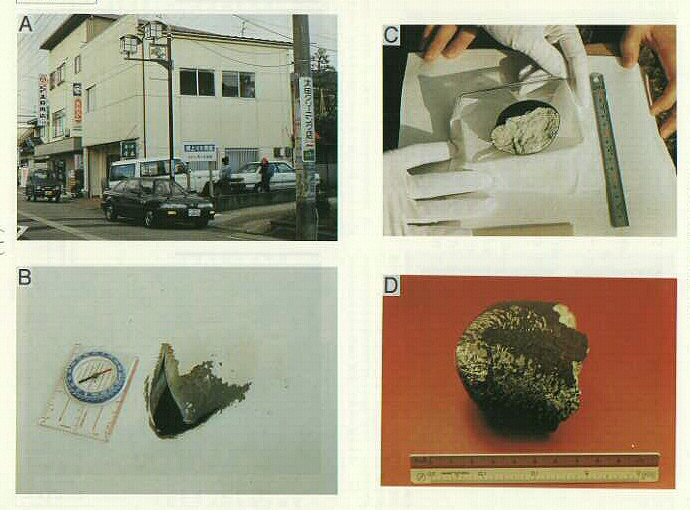are the odds of a meteorite downing an aircraft reasonable?
John at CV asks whether a meteorite could have downed fligh 447?
he concludes it is possible, but not very likely.
As he notes the meteorite hypothesis was also suggested for flight 800 from JFK back in 1996, but careful forensics showed it was due to a fuel vapour explosion in the central tank.
Learning from a Tragedy: Explosions and Flight 800 (.pdf) by Joe Shepherd
The CV comments have much discussion about the validity of the approximations John uses in deriving the odds of an impact on a plane in flight.
There is a simpler way to estimate the odds:
there are about 10-20,000 commercial aircraft in the world.
John tells us the area of some average plane is about 200 m2.
A car has an area of about 4 m2.
There are about 20,000 cars for every commercial airplane - world production of ~ 50 million per year with mean lifetime of 7 years or so per car. We only work to single significant figures here
So the cross-section for a car being hit (ignoring duty factor of plane time in the air and the slightly higher odds of being hit at altitude - due to meteorites burning up before hitting the ground), we conclude there should be about 400 cars hit by meteorites for every airplane hit (ie somewhere between 100 and 1000 hits on cars).
So... well, there are instances of a documented hit of a meteorite on a car:
and the
Park Forest meteorite of 2003 supposedly had fragments hit two cars.
This is necessarily incomplete, but clearly gives the odds of a car being hit at about one per decade.
So the odds of an airplane being hit ought to be of order one per thousand years.
Hence it is unlikely but far from impossible that a commercial airline might be hit by a meteorite sometime in the last 50 years.
Doesn't mean that flight 447 was actually downed by a meteorite impact, but it is not preposterously unlikely.
And, yes, houses and people have been hit - as you might expect.
even a ship...
What is interesting to consider is whether airplanes have been hit sitting on the ground, and whether military aircraft may have been hit by meteorites.




What are the chances of a meteorite being hit by a meteorite?
very low - although there are many meteorites they are quite small on average, and more importantly don't spend much time in the atmosphere so the time averaged cross section is smaller by many orders of magnitude.
On the other hand, meterorite falls do occur in correlated clusters, and those could bump into each other in the atmosphere, so the calculation is non-trivial
the odds of a meteorite lying on or just under the surface of the earth being hit by another meteorite are much higher and approach certainty over long enough time
is altitude really negligible? rough calc gave a mass column between 10 km and sea level of 600 g/cm^2, so a meteorite would sweep up 10-100 kg of air on the way in, more if it comes in at an angle. that's 1-10 times bigger than a typical meteorite, so slowing/breakup might be significant.
Sometime, ages ago, I read an article about a passenger jet that had been hit by a meteor that came through the ceiling and lodged under the floor. The incident probably occurring in the 1960s.
Trying to find some reference to this I came across this,
http://select.nytimes.com/gst/abstract.html?res=F70914F6385C167B93CAA81…
an article from 18 June 1944. I don't subscribe to the Times so I can't read the article, but it sure sounds intriguing,
Britain Perfecting Antidote As Robot Plague Increases; NEW NAZI WEAPON APPEARS OVER ENGLAND AND THE BRITISH VERSION OF THE ROBOT BRITISH PERFECTING ANTIDOTE TO ROBOT
Altitude certainly does matter, and increases the odds of airplane hits, since there may be meteors that can do damage at 10km altitude but don't make it to the ground.
But the numbers for this are sensitive to speed, composition and even meteorite shape, and at midnight doing a blog post I am not going to work through this - nor do I have the data at hand.
It was meant more as a sanity check - if there is any finite chance of an aircraft hit, there must have been many automobile hits - and lo and behold there have been several documented, which interested me since I only knew of the one until I started looking.
Google is very good at this stuff. Interestingly many house impacts also, and reports of impact are biased low - people don't recognise what happened, or are not believed.
I can't access the NYT article right now, but I infer from the title that it is discussing the V-1 "robot" bombers.
The Gloster Meteor jet fighter was held back from frontline service, they were delivered in June 1944, but started V-1 interdiction over the UK in July 1944, so that may be what the article refers to, the plans for the Meteor to start and V-1 missions.
I take it meteorites are evenly distributed across the planet?
Aeroplanes aren't.
Meteorites are evenly distributed across the planet as a first approximation.
The rate calculation on CV really only needs a mean flux per area.
The estimate I used is robust as long as cars and planes have similar enough distributions, and the rates look sane, since four cars have been hit in the US (high car number and density and strong reporting bias) in the last 50 years.
as long as cars and planes have similar enough distributions
Big, big assumption. Not many cars in a tight band across the North Atlantic, lots of planes.
It doesn't matter whether cars and planes have the same distribution. It matters whether they have effectively the same sum when convolved with the distribution of meteorite trajectories. So for example, longitude isn't going to matter (since the landing time of meteors is random) and latitude matters if, for example, the meteorite distribution is greater or lesser near the poles - and I don't think that's the case anyway.
This entire discussion is hypothetical to the point of frivolous. Among other things, it is calculating the probability that a plane will be struck by a meteorite, not the probability that it will be downed by a meteorite. Planes have landed successfully with much more damage than the above-pictured car. Furthermore, what are the odds that the plane would be struck by a meteorite while it happened to be flying through a strong high-altitude thunderstorm?
There are two separate issues:
whether this flight was downed by a meteorite impact - which is very unlikely but conceivable;
and, whether some airplane might with any reasonable probability be hit in flight at some time by a meteorite - which is possible and has an interestingly high probability.
Meteorite impacts are not completely uniform, there should be a weak latitudinal dependence (slightly less flux at the pole), and possibly a slight morning/evening asymmetry due to Earth's rotation (for meteorites getting to low altitude or the surface), but the data is not good enough to make authoritative statements. These would have negligible effects compared to the larger uncertainties in the rates.
The car impact rate provides a calibrated sanity check on the rate - since it must be 2-3 orders of magnitude higher.
Up to reporting bias, the estimated rates are consistent with observation - that several cars are known to have been hit by meteorites, and no airplane is known to have been hit.
I think you could reduce your risk of being in a meteor-induced plane crash by flying in the afternoon and evening. between midnight and noon you're on the side of the earth facing forward in orbit.
Argh... Steinn beat me to it... gotta learn to reload before commenting if I've been away from the computer for a bit.
(Two Years Later, and found the blog). Hey, much better chances of having a near miss. One question. What would be the average distribution of meteorites in the ground? How long would it take, how far would one have to walk with a metal detector? How many horseshoes? It would depend on weathering, age of landscape etc.Whether you happened to be in or near a strewnfield etc. I feel that most of the earth must be lightly dusted with meteoric debris, so the iron in our haemoglobin must, (since we eat McDonalds etc, made from grazing animals), it must be significantly sourced from space. To get back to earth, all our atoms are wandering in spcae.Have been forever.